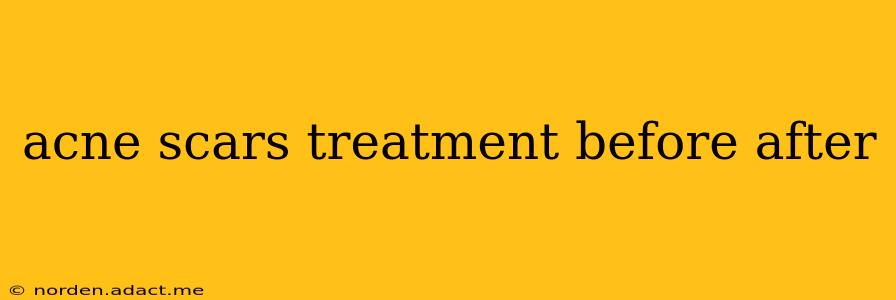Acne scars. The unwelcome souvenirs of a breakout past, they can significantly impact self-esteem and confidence. But the good news is that numerous treatments are available to minimize their appearance and even achieve remarkable before-and-after results. This comprehensive guide explores various acne scar treatment options, highlighting their effectiveness, potential side effects, and the kind of results you can realistically expect.
What are the Different Types of Acne Scars?
Before diving into treatments, it's crucial to understand the different types of acne scars. This is because the best treatment strategy depends heavily on the type of scarring you have. Common types include:
- Ice Pick Scars: Deep, narrow, and pitted scars that resemble ice pick holes. These are notoriously difficult to treat.
- Boxcar Scars: Broad, square, or rectangular depressions with sharply defined edges.
- Rolling Scars: Widespread, undulating depressions that create a bumpy, uneven texture on the skin.
- Hypertrophic Scars: Raised, red, and often itchy scars that are thicker than the surrounding skin. These are a result of excessive collagen production.
- Keloid Scars: Similar to hypertrophic scars but extend beyond the original wound boundary. These are more prevalent in people with darker skin tones.
What are the Most Effective Acne Scar Treatments?
Numerous treatments are available, offering varying degrees of effectiveness depending on the scar type and severity. Here are some of the most common and effective options:
Topical Treatments:
- Retinoids: These vitamin A derivatives help stimulate collagen production and improve skin texture. They can reduce the appearance of mild acne scars.
- Chemical Peels: These treatments use chemical solutions to exfoliate the skin, removing damaged layers and promoting cell turnover. Different peel strengths are available, ranging from mild to aggressive.
- Topical Steroids: For hypertrophic and keloid scars, topical steroids can help reduce inflammation and flatten the scar tissue.
In-Office Procedures:
- Microneedling: This minimally invasive procedure uses tiny needles to create controlled micro-injuries in the skin, stimulating collagen production and improving skin texture. It can be effective for various scar types.
- Laser Resurfacing: Different laser types target different aspects of acne scarring. Ablative lasers remove damaged skin layers, while non-ablative lasers stimulate collagen production without removing tissue.
- Dermal Fillers: Fillers such as hyaluronic acid can be injected into depressed scars to fill them in and improve their appearance. This is often a good option for boxcar and rolling scars.
- Subcision: This procedure involves inserting a needle under the scar to release the tethering that pulls the skin down, improving the appearance of depressed scars.
Surgical Options:
- Surgical Excision: This involves surgically removing the scar and then closing the wound to minimize its appearance. This is most often used for individual, raised scars.
- Punch Excision: A small punch tool is used to remove the scar, and the wound is then closed.
How Long Does it Take to See Results from Acne Scar Treatment?
The timeframe for seeing results varies greatly depending on the treatment chosen and the individual's response. Some treatments, like topical retinoids, may take several months to show noticeable improvement. In-office procedures like microneedling may show some improvement after a single session, but a series of treatments is usually recommended for optimal results. Laser resurfacing and surgical options provide more immediate, noticeable changes but often require a longer recovery period.
What are the Potential Side Effects of Acne Scar Treatment?
Potential side effects vary depending on the treatment. Some common side effects include redness, swelling, bruising, and temporary hyperpigmentation. More aggressive treatments such as laser resurfacing may carry a higher risk of complications, such as scarring, infection, and changes in skin pigmentation. It's essential to discuss potential risks and side effects with your dermatologist before undergoing any treatment.
What is the Cost of Acne Scar Treatment?
The cost of acne scar treatment varies widely depending on the type of treatment, the number of sessions required, and the geographical location. Topical treatments are generally the most affordable, while surgical options and laser treatments tend to be the most expensive.
How Can I Choose the Right Acne Scar Treatment for Me?
Choosing the right acne scar treatment requires a consultation with a qualified dermatologist. They will assess your skin type, scar type, and overall health to recommend the most appropriate treatment plan. Don't hesitate to ask questions and discuss your expectations and concerns. Before and after photos can be helpful in guiding your decision-making process.
Can I Prevent Acne Scars in the Future?
While completely preventing acne scars is impossible, there are things you can do to minimize your risk:
- Early treatment of acne: The earlier you treat acne breakouts, the lower your risk of developing scars.
- Avoid picking or squeezing pimples: Picking or squeezing pimples can increase the risk of scarring.
- Protect your skin from the sun: Sun exposure can worsen acne scarring, so always use sunscreen.
This comprehensive guide offers a starting point in understanding acne scar treatment options. However, remember that individual results vary, and consulting a dermatologist is crucial for personalized advice and a tailored treatment plan. Remember, achieving clear, healthy skin is a journey, not a race. Be patient, follow your dermatologist's recommendations, and celebrate each milestone along the way.
